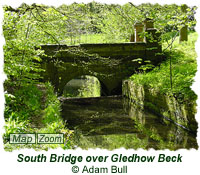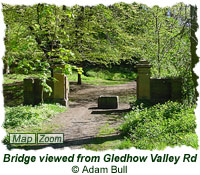



|
|
The History of Gledhow Hall
The following information was kindly provided by Pavinder Chana (originally as part of a case study for a Landscape History course) and has been reproduced with his permission.
Gledhow Hall stands on Gledhow Lane at its junction with Gledhow Wood Road. The top of the hill is known locally as Little Switzerland and overlooks Gledhow Valley Road.

The Hall was built on monastic land. In 1601 the estate was purchased from Elizabeth I by the Thwaites family. John Thwaites - Alderman of Leeds, died at Gledhow in 1671 aged eighty-five. His son-in-law, Edward Waddington, inherited the estate and it was he who built the curious Gipton Spa House in its grounds. To the south the site is open to Gledhow Valley Road with access across the lake via two bridges. The southern bridge is of stone and is a substantial structure.
The Hall changed hands several times until 1764, when, on the death of William Wilson, merchant, the estate was sold to Jeremiah Dixon. During his time at Gledhow Jeremiah made considerable additions to the estate and redesigned the surrounding gardens, pleasure grounds, plantations and woods. He was responsible for the introduction of the Apherhously pine which became known as the Gledhow Pine. His initials and the date 1768 are still to be seen on the bridge across Gledhow Lane. Jeremiah Dixon retired to Gledhow where he led the life of the country squire. On his death in 1782 the estate passed to his eldest son John. John, Colonel of West Yorkshire Militia and Deputy Lieutenant for the West Riding, regularly gave military displays on Chapletown Moor. At the conclusion of the Napoleonic Wars however, his interest in the Militia and Gledhow lapsed, and lacking his father's interest sold the Hall and moved to the other family estate in Norfolk. During the next sixty years Glehow Hall was home to several famous families, the Becketts, the Benyons and the Coopers. Extensive additions were made to the north and west side of the house and in 1878 the Hall was put up for sale. The property was purchased by James Kitson, later Baron Airedale, head of the Monkbridge Iron and Steel Company. A staunch Liberal, he became the first Lord Mayor of Leeds in 1896 and in 1902 he entertained the Earl of Roseberry at Gledhow, with two hundred torch bearers escorting them to the Hall. Prime Minister Gladstone was also a frequent visitor to the Hall. It was James Kitson who commissioned the impressive hand-painted Burmantofts "faience" tile bathroom, designed for a visit by the Prince of Wales in 1885. During the First World War (1914-18), the Hall was used as a Military Hospital. Lord Airedale offered his Leeds residence to the authorities in the early stages of the war, and the Hall was turned into a Voluntary Aid Detachment (VAD) Hospital, almost entirely worked by voluntary aid staff. An original water-colour by J.M.W. Turner, 1816, shows the house across the valley. The painting is now in private ownership. In recent years the Hall was converted into private flats and, unfortunately, is not open to the public. However there is usually an open day once a year when you can see part of it, including the Burmantofts "faience" tile bathroom. Details of these open days can be found in the Events section of the Leeds Civic Trust web site under "Heritage Open Days". |
| |||
 |

